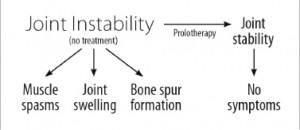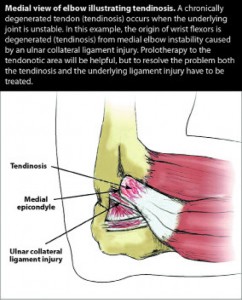Have you suffered an injury from golf, or one that is preventing you from playing golf? Over 50% of golfers suffer from traumatic or overuse injuries at some point. Golfing puts significant stress on the body, requiring aggressive twisting and torque which can lead to injury. While prevention is important through using good form, proper equipment, and CORE strengthening, when an injury occurs, repairing it in order to get back out on the course becomes even more urgent. For the year-round golfer in Florida, regenerative injection therapies (Prolotherapy) provide an excellent alternative to cortisone injections, pain medications, and joint surgery.
Common pain in golfers
Low back pain is the most common golfing injury. The golf swing, and the hunched over stance many take, puts significant strain and stress on the lower back. Back muscles are held in contracted positions in order to obtain the proper form. Professional golfers, like Tiger Woods, who underwent a microdiscectomy last April, have the highest incidence of back injury of all professional athletes. Countless hours on the driving range cause overuse injuries to the back, while brute force used to hit the prodigious drive results in traumatic injuries. Amateur golfers generate 80% more torque and shear loads than the professional golfer during the golf swing, leading to back injury from excess exertion and force.
 Elbow injuries are the second most commonly injured area in golfers. Golfer’s Elbow (medial epicondylitis) and Tennis Elbow (lateral epicondylitis) are both overuse injuries causing irritation of the tend on attachment to the bone. Both of these conditions increase with age and frequency of play. Any action that places a repetitive and prolonged strain on the forearm muscles will tend to strain and overwork those muscles and their tendon attachment. Poor swing mechanics are also a causative factor. Medial epicondylitis may develop from hitting the ground during the golf shot, and lateral epicondylitis may be caused by over-swinging.
Elbow injuries are the second most commonly injured area in golfers. Golfer’s Elbow (medial epicondylitis) and Tennis Elbow (lateral epicondylitis) are both overuse injuries causing irritation of the tend on attachment to the bone. Both of these conditions increase with age and frequency of play. Any action that places a repetitive and prolonged strain on the forearm muscles will tend to strain and overwork those muscles and their tendon attachment. Poor swing mechanics are also a causative factor. Medial epicondylitis may develop from hitting the ground during the golf shot, and lateral epicondylitis may be caused by over-swinging.
(See Figure 1.)
Shoulder pain is the third area with a high rate of injury in golfers. Due to the positioning in the backswing, the non-dominant shoulder is usually injured. Impingement syndrome, tendonitis, labral injuries, dislocations, rotator cuff injuries, and acromioclavicular osteoarthritis are common.
What is really causing your pain?
Joint Instability.
 While injured golfers may have a diagnosis of tendonitis, a bulging disc, or torn ligament on MRI, these all have a common denominator to be addressed: underlying joint instability. Ligaments and tendons are the tissues that keep our joints stable. When the ligaments are too lax or damaged, the surrounding muscles overcompensate to provide stability. However, these overcompensating muscles eventually become very tight and lead to muscle spasms and an awkward, painful swing. Over time, joints attempt stabilization by overgrowing bone, better known as arthritis. A preferable option for golfers to stabilize the joint naturally can be Prolotherapy, a regenerative injection treatment that stimulates repair of the painful area. (See Figure 2.)
While injured golfers may have a diagnosis of tendonitis, a bulging disc, or torn ligament on MRI, these all have a common denominator to be addressed: underlying joint instability. Ligaments and tendons are the tissues that keep our joints stable. When the ligaments are too lax or damaged, the surrounding muscles overcompensate to provide stability. However, these overcompensating muscles eventually become very tight and lead to muscle spasms and an awkward, painful swing. Over time, joints attempt stabilization by overgrowing bone, better known as arthritis. A preferable option for golfers to stabilize the joint naturally can be Prolotherapy, a regenerative injection treatment that stimulates repair of the painful area. (See Figure 2.)
Cumulative trauma through years of golf can result in small tears and laxity of the ligaments. In the back, for instance, the twisting, tearing and stretching of the vertebral ligaments causes instability and results in back pain. Prolotherapy treatment to such ligaments as the supraspinatus, infraspinatus, iliolumbar and sacroiliac, repairs the ligament tissue, strengthens the spine and eliminates pain. When it comes to elbow pain, it is most commonly due to ligament and tendon sprains such as the annular ligament and the ulnar collateral ligament, which both respond well to Prolotherapy. Shoulder pain can have many causes because it is a highly mobile joint with many muscle and ligament attachments that can become unstable through repeated use without sufficient rest, bad form, or trauma. Treatment to the various ligament and tendon attachments around the shoulder, including the biceps tendon, rotator cuff tendons, and joint capsule can be used to re-tighten and strengthen the joint to provide the golfer the power and stability needed for a strong swing.
Use your own cells
for repairing sports injuries
Cellular Prolotherapy is an option for more severe tears, injuries, and arthritis. Specific cells from a person’s own blood and stem cells are concentrated and used to stimulate repair of tissue. Platelet Rich Plasma (PRP) is a type of Prolotherapy treatment that uses concentrated growth factors from a person’s own blood. More advanced Stem Cell Prolotherapy uses cells from a person’s bone marrow and/or fat cells. These methods give severe injuries and arthritic joints a supercharged boost of healing cells right to the area of cellular deficiency.
Golfers have more options for treating injuries than they may realize. Seeing a Prolotherapist can get a person back on the course fast because Prolotherapy requires almost no down time. It is ideal for professionals who need to continue training and the casual golfer who doesn’t want to stop their beloved sport.
Prolotherapy Specialists:
Ross A. Hauser, MD.
Danielle R. Steilen. MMS, PA-C
Timothy L. Speciale, DO
239-303-4546 | www.CaringMedical.com








